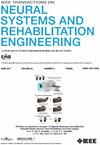语音图像生成速率对神经活动和脑机接口解码性能的影响:fNIRS研究。
IF 4.8
2区 医学
Q2 ENGINEERING, BIOMEDICAL
IEEE Transactions on Neural Systems and Rehabilitation Engineering
Pub Date : 2025-03-18
DOI:10.1109/TNSRE.2025.3552606
引用次数: 0
摘要
脑机接口(BCI)使中风患者能够主动调节神经活动,促进神经可塑性,从而加速恢复过程。功能近红外光谱(fNIRS)由于其便携、无创、安全等优点,已成为应用最广泛的神经影像学技术之一。目前脑机接口的研究主要集中在提高解码性能上。然而,脑卒中康复的一个关键方面在于在受损脑区诱导更强的皮层激活,从而加速脑功能的恢复。本研究探讨了语音图像生成速率对神经活动的调控机制及其对脑机接口解码性能的影响。随着生成速率从1个单词/4秒增加到1个单词/2秒,最后增加到1个单词/1秒,言语相关脑区神经活动稳步增强。相应的,语音图像检测任务的准确率也从83.83%提高到85.39%,并最终呈现出显著的提高,达到88.28%。此外,“是”和“否”语音图像任务之间的神经活动差异随着生成率的增加而变得更加明显,导致分类性能从62.81%提高到65.78%,最终提高到67.50%。本研究表明,语音图像生成过程中,大部分与语言相关的脑区神经活动水平随着生成速率的增加而增强。因此,加快语音图像的生成速度会导致不同任务之间更强的神经活动和更明显的反应模式,这有可能促进具有更高神经可塑性诱导和更高解码性能的BCI反馈系统的发展。本文章由计算机程序翻译,如有差异,请以英文原文为准。
Impact of Generation Rate of Speech Imagery on Neural Activity and BCI Decoding Performance: A fNIRS Study
Brain-computer interface (BCI) enables stroke patients to actively modulate neural activity, fostering neuroplasticity and thereby accelerating the recovery process. Due to being portable, non-invasive, and safe, functional near-infrared spectroscopy (fNIRS) has become one of the most widely used neuroimaging techniques. Current BCI research primarily focuses on improving the decoding performance. However, a key aspect of stroke rehabilitation lies in inducing stronger cortical activations in the damaged brain areas, thereby accelerating the recovery of brain functions. This study investigated the regulatory mechanism of the generation rate of speech imagery on neural activity and its impact on BCI decoding performance based on fNIRS. As the generation rate increased from 1 word/4 s to 1 word/2 s, and finally to 1 word/1 s, neural activity in speech-related brain regions steadily enhanced. Correspondingly, the accuracy of detecting speech imagery tasks increased from 83.83% to 85.39%, and ultimately showed a significant improvement, reaching 88.28%. Additionally, the differences in neural activities between the “yes” and “no” speech imagery tasks became more pronounced as the generation rate increased, leading to an improvement in classification performance from 62.81% to 65.78%, and ultimately to 67.50%. This study demonstrates that the neural activity level of most speech-related brain regions during speech imagery enhanced as the generation rate increased. Therefore, accelerating the generation rate of speech imagery induces stronger neural activity and more distinct response patterns between different tasks, which holds the potential to facilitate the development of a BCI feedback system with higher neuroplasticity induction and improved decoding performance.
求助全文
通过发布文献求助,成功后即可免费获取论文全文。
去求助
来源期刊
CiteScore
8.60
自引率
8.20%
发文量
479
审稿时长
6-12 weeks
期刊介绍:
Rehabilitative and neural aspects of biomedical engineering, including functional electrical stimulation, acoustic dynamics, human performance measurement and analysis, nerve stimulation, electromyography, motor control and stimulation; and hardware and software applications for rehabilitation engineering and assistive devices.

 求助内容:
求助内容: 应助结果提醒方式:
应助结果提醒方式:


